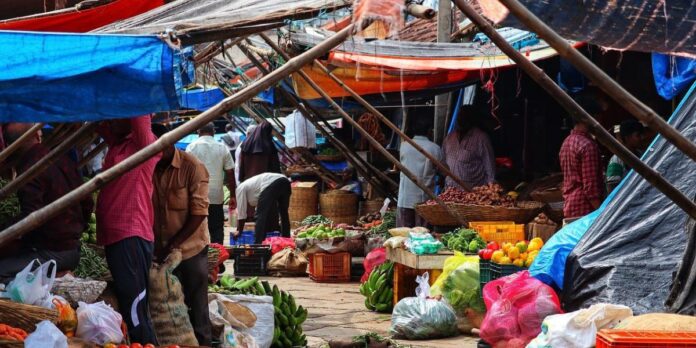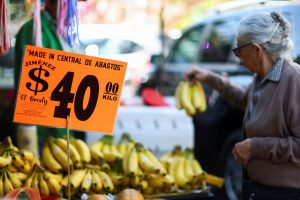Reading a semblance of relief in India’s June retail inflation figures, which eased slightly to 7.01% from 7.04% in May, may be a bit premature.
Supply chains, all over the world, continue to hemorrhage. The geopolitical tensions revealed after the crisis between Russia and Ukraine continue to haunt the global macroeconomic situation. And a poor monsoon performance in the future may nip in the bud any hope that inflation will subside.
In any case, the average citizen continues to feel the bite of retail inflation, given that food and beverage inflation was high, at 7.56%, in June, due to cereal prices , vegetables, milk and meat skyrocketed. Transport costs and damage caused by the heat wave during the summer months pushed up vegetable prices. In fact, within vegetables, the prices of tomatoes have experienced an incredible rise in the course of the last twelve months.
The median retail price of tomatoes, according to a research note from rating agency CareEdge, has soared nearly 145% in June 2022 from a year earlier. Meat and milk prices have moved north due to high demand from restaurants and high feed prices.
Month-on-month, the food and beverage index rose 0.9% in June 2022, with nine of the 12 subgroups increasing across the board, including eggs (+5.2%), vegetables (+4.3 %) and spices (+1.2%).
In year-on-year terms, the inflation of spices (to +11.0% from +9.9%), cereals and products (to +5.7% from +5.3%), meat and fish (to +8.6% from +8.2%), fruits (to +3.1% from +2.3%), and milk and products (to +6.1% from +5.6%) were hardened in June 2022, relative to May 2022. A slowdown in food inflation was observed in the category of oils and fats, which decreased by 0.7% in June 2022, compared to a rise of 2.8 % in June 2021.

Apparently, the bite will not be limited to ordinary mortals. According to Crisil Research, the spike in agricultural commodity prices will also hurt food manufacturing companies. According to a research note dated July 12, it has pointed out that the prices of essential agricultural commodities will continue to be marked by greater volatility that will add to the agony of food manufacturers for national consumption in this exercise.
The median retail price of tomatoes, according to a research note from rating agency CareEdge, has soared nearly 145% in June 2022 from a year earlier
Crisil Research forecasts that the prices of wheat and maida will rise between 7 and 8%, that those of flour and the gram will shoot up between 6 and 7% and that those of milk and sugar will move towards the north by a moderate 1%. On the other hand, it forecasts that the prices of palm and soybean oil, which have been depleting the monthly budgets of Indian households, will tend to fall from a high base by 16-17% and that of sunflower oil by 10%. -12%.
The prices of food and raw materials have experienced strong fluctuations in recent years. With the onslaught of the pandemic and the sudden drop in demand, wheat and sugar were down 14% and 2% in FY21, but up 11% and 7%, respectively, in FY22 , as the impact of the pandemic faded and demand from food processors rebounded. Since February 2022, when the conflict between Russia and Ukraine began, these commodities have risen 19% and 6%, respectively.
India Hits Record Trade Deficit in June, Mounting Pressure on Rupee
“Edible oil prices, for their part, soared 35% in fiscal year 2021 and another 40% in fiscal year 2022 due to the pandemic and lower supply from major oil-producing countries, such as South America, Brazil and Malaysia, and have risen another 40% since the start of the war,” says Crisil Research.
For the time being, the Indian government is pinning its hopes on the continued decline in crude oil prices, which, in month-on-month terms, have suffered a decent drop of 6.1%, to below 110 dollars per barrel, due to to recession fears and the wave of monetary tightening affecting economies around the world. However, a disruption in current supply – a possibility that seems quite likely given geopolitical tensions and tight supplies – could push crude prices back into the $115-120 per barrel range, robbing the economy. India what little relief it might get from falling prices.
the prices of essential agricultural commodities will continue to be marked by greater volatility that will add to the agony of food manufacturers for domestic consumption this year
Meanwhile, as inflation figures continue to plague the Indian economy, the Reserve Bank of India will stay on its path of rate hikes. Retail inflation is expected to moderate to 6-6.7% this quarter, but this figure will remain outside the RBI’s inflation tolerance band. One way or another, rate hikes by the RBI are a foregone conclusion.
Article republished from The Wire as part of an agreement between both parties to share content. Link to original article:https://thewire.in/economy/india-food-inflation-monthly-budgets-poor-households



![[Img #74675]](https://thelatestnews.world/wp-content/uploads/2024/12/They-discover-a-new-class-of-X-ray-sources-in-the-150x150.jpg)











Add Comment